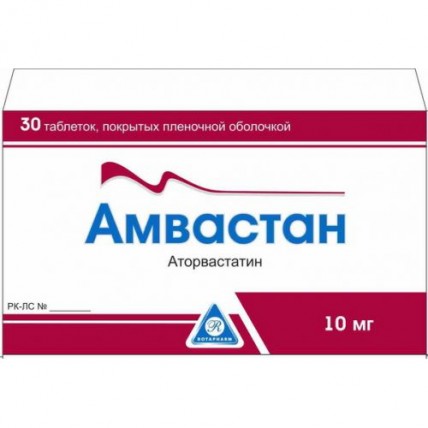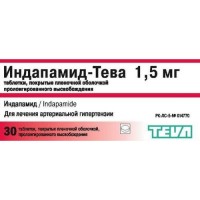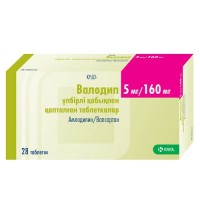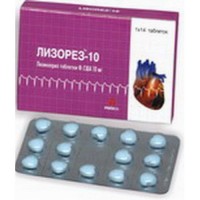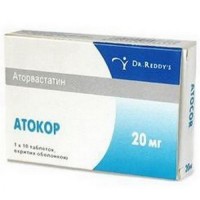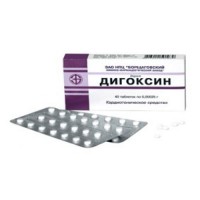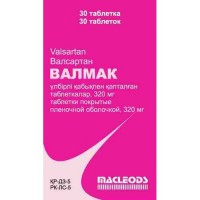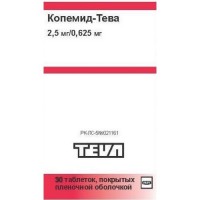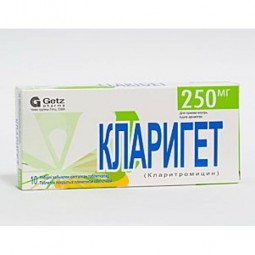Amvastan 30s 10 mg film-coated tablets
- $25.00
The instruction for medical use
of AMBACTAH medicine
the Trade name
Amvastan
the International unlicensed
name Atorvastatin Lekarstvennaya
the Tablet form, film coated, 10 mg, 20 mg, 40 mg, 80 mg
Structure
One tablet contains
active agent - calcium of an atorvastatin trihydrate of 10.85 mg, 21.7 mg, 43.4 mg, 86.8 mg (equivalent to an atorvastatin) 10, 20, 40 or 80 mg,
excipients: calcium carbonate, lactoses monohydrate, cellulose microcrystalline, sodium of a kroskarmelloz, sucrose stearate, magnesium stearate,
structure of a cover: Opadray white (Y-1-7000): hydroksipropilmetiltsellyuloza 29105 sr, polyethyleneglycol 400, titan dioxide (E171).
Description
Dosage of 10 mg: tablets of white color, film coated,
round, with a biconvex surface.
Dosage of 20 mg: tablets of white color, film coated,
round, with a biconvex surface, with risky on one party.
Dosage of 40 and 80 mg: tablets of white color, film coated,
oblong, with a biconvex surface, with risky on one party.
Pharmacotherapeutic group
Hypolipidemic means. GMG-KoA-reduktazy inhibitor. ATX C10AA05 code
Pharmacological
Pharmacokinetics Absorption properties: Atorvastatin is quickly absorbed after intake, achievement time Sshakh: 1-2 h. The linear dependence between extent of absorption and a dose of drug is revealed. Bioavailability - 14%, system bioavailability of the inhibiting activity concerning GMG-KoA-reduktazy - 30%. The low system bioavailability is caused by presistemny metabolism in a mucous membrane of digestive tract and effect of primary passing through a liver. Food reduces the speed and duration of absorption of drug a little (by 25 and 9% respectively), however decrease in LDL-cholesterol is similar to that at use of an atorvastatin without food. Plasma concentration of an atorvastatin at use is lower in the evening, than in morning (approximately for 30%). Despite this, decrease in LDL happens irrespective of time of administration of drug.
Distribution: the volume of distribution is about 381 l. Extent of linking with proteins of plasma & gt, 98%.
Metabolism: Atorvastatin is metabolized mainly in a liver under the influence of CYP3A4 cytochrome with formation pharmacological of active metabolites - ortho-and parahydroxylated derivatives and various products of beta oxidation. The inhibiting effect of drug concerning GMG-KoA-reduktazy approximately is defined on 70% by activity of the circulating metabolites.
Discharge: It is removed with bile after hepatic and/or extrahepatic metabolism (is not exposed to the significant enterohepatic recirculation). Elimination half-life of an atorvastatin about 14 h, but a half-cycle of the inhibiting activity concerning GMG-KoA-reduktazy makes 20-30 h that is connected with existence of active metabolites. Less than 2% of the dose of drug accepted inside are defined in urine.
Cmax and AUC of an atorvastatin at elderly (65 years are also more senior) for 40 and 30% are respectively higher than those at patients of middle age (has no clinical value).
Diseases of kidneys do not affect plasma concentration of an atorvastatin or decrease in the LDL level, such patients have no need for dose adjustment. It is not removed during a hemodialysis owing to intensive linking with proteins of plasma.
At patients with alcoholic damages of a liver the plasma concentration of an atorvastatin considerably increase (Cmax and AUC increases in hard cases in 16 and 11 times respectively).
Pharmacodynamics
Hypolipidemic means. Atorvastatin - a selection competitive inhibitor of GMG-KoA-reduktazy - the enzyme turning Z-hydroksi-3-metilglutarilkoenzim And into mevalonovy acid, being the predecessor of sterols including cholesterol. TG and cholesterol in a liver are included LPONP, come to plasma and are transported in peripheral fabrics. Are formed by LDL of LPONP during interaction with LDL receptors. Reduces levels of cholesterol and lipoproteins in plasma due to oppression of GMG-KoA-reduktazy, synthesis of cholesterol in a liver and increases in number of 'hepatic' receptors of LDL at surfaces of cells that leads to strengthening of capture and catabolism of LDL. Reduces formation of LDL, causes the significant and permanent increase in activity of LDL receptors. Reduces the LDL level at patients with a homozygous family hypercholesterolemia which usually does not give in to therapy by hypolipidemic medicines. Reduces the level of the general cholesterol by 30-46%, LDL - for 41-61%, apolipoprotein B - for 34-50% and TG - for 14-33%, causes increase in level holesterina-LPVP and apolipoprotein A. Dozozavisimo reduces the LDL level at patients with the homozygous hereditary hypercholesterolemia resistant to therapy with other hypolipidemic medicines. Authentically reduces risk of development of ischemic complications (including development of death from a myocardial infarction) by 16%, risk of repeated hospitalization concerning the stenocardia which is followed by symptoms of ischemia of a myocardium - for 26%. Has no cancerogenic and mutagen effect. The therapeutic effect is reached in 2 weeks after the beginning of therapy, reaches a maximum in 4 weeks and remains during the entire period of treatment.
Indications
- in combination with a diet for decrease in the increased level of the general cholesterol, Hs-LPNP, apolipoprotein B and triglycerides, increase in the Hs-LPVP level at patients with primary hypercholesterolemia (heterozygous family and single) and the mixed dislipidemiya (the IIa and IIb types across Fredrikson)
- in combination with a diet for treatment of patients with the increased serumal levels of triglycerides (type IV across Fredrikson)
- patients with a disbetalipoproteinemiya (type III across Fredrikson) at whom the dietotherapy does not give adequate effect
- for decrease in levels of the general cholesterol and Hs-LPNP at patients with a homozygous family hypercholesterolemia, at insufficient efficiency of a dietotherapy and other methods of not pharmacological therapy
- in combination with a diet for decrease in the increased level of the general cholesterol, Hs-LPNP and apolipoprotein B at boys and girls (in the postmenarkhealny period) at the age of 10-17 years, with a heterozygous family hypercholesterolemia, even on condition of observance of an adequate diet, if:
a) the Hs-LPNP level remains also to gt, 190 mg/dl or
b) the Hs-LPNP level remain also to gt, 160 mg/dl and:
in the family anamnesis the developing of cardiovascular diseases at sick children takes place there are 2 and more other risk factors of developing of cardiovascular diseases
- for reduction of risk of death, risk of developing a myocardial infarction, a stroke, repeated hospitalization concerning stenocardia and need for revascularization, at patients with diseases of a cardiovascular system (including at the patients without clinical manifestations of coronary heart disease but having the increased risk factors of its emergence: advanced age is more senior than 55 years, nicotine addiction, arterial hypertension, genetic predisposition), including against the background of a dislipidemiya.
The route of administration and doses
Before an initiation of treatment atorvastatiny patients should be transferred to the standard, reducing cholesterol level, a diet and the program of decrease in body weight, in particular at the patients having obesity for control of a hypercholesterolemia. Patients have to keep to such diet during treatment.
A hypercholesterolemia (heterozygous family and single) and the mixed dislipidemiya (the IIa and IIb No types to Fredrikson).
It is recommended to begin with doses 10-20 mg 1 times/day. To the patients demanding considerable decrease in LDL-cholesterol (more than 45%), the initial dose makes 40 mg. Range of doses: 10-80 mg/days. The drug is taken inside at any time with food or irrespective of meal time. Doses need to be selected according to main objectives of therapy and reaction of the patient to treatment. In an initiation of treatment and/or during increase in a dose it is necessary to estimate the level of lipids within 2-4 weeks and to correct a dose if necessary.
Homozygous family hypercholesterolemia.
Dosages from 10 to 80 mg/day are used. Atorvastatin is used in addition to other types of therapy or if other types of lipidosnizhayushchy therapy are inaccessible.
An initial dose at prevention of coronary heart disease for adult-10 mg 1 times/day.
A heterozygous family hypercholesterolemia in pediatrics (patients at the age of 10-17 years).
The recommended initial dose of 10 mg 1 time/day, the maximum recommended dosage of 20 mg 1 time/day (purpose of higher doses is not studied at patients of this age). It is necessary to change a dose with an interval not less than 4 weeks under control of a lipidic profile of plasma.
Side effects
In controlled clinical trials & lt, 2% of patients stopped treatment owing to the side effects inherent in an atorvastatin.
Very often (1% and more)
- insomnia, dreadful dreams, a headache, an asthenic syndrome
- nausea, an eructation, diarrhea, abdominal pain, dyspepsia, a meteorism, a constipation
- neck pain, myalgia
- a nasopharyngitis, throat, throat pain, nasal bleedings
Often (less than 1%)
- abnormal indicators of function of a liver, indistinct sight
- an indisposition, fatigue, dizziness, amnesia, paresthesia, peripheral neuropathy, a hypesthesia
- fervescence
- emergence of leukocytes in urine
- vomiting, a food faddism, anorexia, hepatitis, pancreatitis, cholestatic jaundice
- a dorsodynia, spasms, a miositis, a myopathy, an arthralgia, extremity pain, a rhabdomyolysis
- urticaria, an itching, skin rash, an anaphylaxis, bullous rash, a polymorphic exudative erythema (including Stephens-Johnson's syndrome), a Lyell's disease
- thrombocytopenia
- a rupture of a sinew
- hypo - or a hyperglycemia, increase in activity of serumal KFK.
- impotence, peripheral hypostases, increase in body weight, a stethalgia, a secondary renal failure, an alopecia, sonitus, exhaustion
of the Contraindication
- hypersensitivity to drug components
- liver diseases in an active stage or increase in level of hepatic transaminases (it is triple exceeding an upper limit of normal level) not clear genesis
- pregnancy and the period of a lactation
- the women who are planning pregnancy, not using adequate contraceptives
- patients with a hereditary lactose intolerance, deficiency of Lapp-lactases enzyme, malabsorption of a glucose/galactose
Medicinal interactions
Risk of development of a myopathy raises at treatment by drugs of this class raises at combined use with the cyclosporines derivative of fibroyevy acid, Niacinum, erythromycin, antifungal drugs of an azolovy row. At a concomitant use in Amvastan and the suspension containing magnesium and aluminum hydroxides the concentration of an atorvastatin in blood plasma approximately decreased by 35%, however extent of reduction of the Hs-LPNP level at the same time did not change.
Atorvastatin slightly increases concentration of ethinylestradiol, Norethisteronum (norethindrone) in blood plasma. This effect should be considered when choosing an oral contraceptive for the woman receiving Amva-stan.
At repeated combined use of digoxin and 10 mg of an atorvastatin equilibrium concentration of digoxin in plasma do not change. Nevertheless, the subsequent daily use of 80 mg of an atorvastatin increases concentration of digoxin approximately by 20%. The patients accepting digoxin need to be controlled properly.
Reduction of concentration of an atorvastatin in blood plasma at joint reception is possible with kolestipoly, at the same time the hypolipidemic effect amplifies.
At simultaneous use of erythromycin (500 mg are 4 times/days old) and the kla-ritromitsina (500 mg are 2 times/days old) moderately raises concentration of an atorvastatin in blood plasma, risk of development of a myopathy increases. Concentration of an atorvastatin in blood plasma did not change at simultaneous use of Amvastan (10 mg are 1 times/day old) and azithromycin (500 mg are 1 times/day old).
At simultaneous use with diltiazem, verapamil, izradipiny increase in concentration of an atorvastatin in blood plasma and increase in risk of development of a myopathy is possible.
Increase in risk of development of a myopathy is observed at simultaneous use of an itrakonazol with atorvastatiny because of substantial increase of concentration of the last in blood plasma.
At simultaneous use atorvastatin does not influence pharmacokinetics of antipyrine (phenazone), a terfenadin.
It is necessary to be careful because of increase in risk of decrease in endogenous steroid goromon at reception of an atorvastatin with Cimetidinum, ketoko-nazoly, Spironolactonum.
Atorvastatin does not render clinically significant effect on a prothrombin time when using by the patients receiving warfarin. At simultaneous use of an amlodipin of 10 mg and Amvastan of 80 mg the pharmacokinetics of the last in an equilibrium state did not change. Clinically significant undesirable interaction of Amvastan and antihypertensive drugs is noted.
Simultaneous use of Amvastan with the protease inhibitors which are inhibitors of P450 ZA4 cytochrome is followed by increase in concentration of an atorvastatin in blood plasma.
The grapefruit juice use during therapy by drug can lead to increase in concentration of an atorvastatin in blood plasma. The patients taking the drug have to avoid the use of this juice. The St. John's wort can reduce concentration of an atorvastatin.
Can lead the special indications Use of Inhibitors of GMG-KoA-reduktazy for decrease in level of lipids in blood to change of the biochemical indicators reflecting function of a liver. Function of a liver should be controlled before therapy, in 6 and 12 weeks after the beginning of reception of an atorvastatin, after each increase in a dose and also periodically, for example, each 6 months.
With care it is necessary to appoint drug in liver diseases in the anamnesis, heavy disturbances of electrolytic balance, endocrine and metabolic disturbances, an alcoholism, arterial hypotension,
heavy acute infections (sepsis), uncontrollable epilepsy, extensive surgical interventions, injuries, diseases of skeletal muscles. At use of an atorvastatin, as well as other means of this class, rhabdomyolysis cases with the acute renal failure caused by a myoglobinuria are described. Therapy by drug should be stopped temporarily or to cancel completely at emergence of signs of a possible myopathy or presence of risk factor of developing a renal failure against the background of a rhabdomyolysis (for example, a heavy acute infection, arterial hypotension, serious operation, an injury, heavy exchange, endocrine and electrolytic disturbances and uncontrollable spasms).
Patients need to be warned that treatment atorvastatiny can cause a myopathy. The diagnosis of a myopathy (pain and weakness in muscles in combination with increase in activity of a kreatinfosfoki-naza (KFK) more than by 10 times in comparison with the upper bound of norm) should be assumed at patients with widespread myalgias, morbidity or weakness of muscles and/or the significant increase in activity of KFK. Patients need to be warned that they should report immediately to the doctor about appearance of inexplicable pains or weakness in muscles if they are followed by an indisposition or fever. Therapy atorvastatiny it is necessary to stop in case of the significant increase in activity KFK or in the presence of the confirmed or expected myopathy. The risk of a myopathy at treatment by other drugs of this class increased at simultaneous use of cyclosporine, fibrat, erythromycin, niacin or azolny antifungal means. Appointing atorvastatin in a combination with these means in hypolipidemic doses, it is necessary to weigh carefully expected advantage and risk of treatment, to regularly observe patients for the purpose of detection of pains or weakness in muscles, especially within the first months of treatment and during the periods of increase in a dose of any drug. In similar situations it is possible to recommend periodic determination of activity of KFK though such control does not allow to prevent development of a heavy myopathy.
Use in pediatrics
the Clinical data on efficiency and safety of use of drug for children are absent. Atorvastatin can be appointed to children only the specialist doctor. Experience of use of an atorvastatin for treatment of children is limited only to small population of patients (age of 10-17 years) suffering from some forms of a heavy dislipidemiya. The recommended initial daily dose of drug for treatment of a heterozygous family hypercholesterolemia makes 10 mg, depending on efficiency and tolerance of drug it can be increased up to 80 mg a day. The subsequent observation of development of these children was not carried out.
Pregnancy
of the Woman of reproductive age during treatment have to use appropriate means of contraception. Atorvastatin it is possible to apply at women of reproductive age only if pregnancy probability very low, the patient has to be informed on possible risk for a fruit at treatment atorvastatiny.
Features of influence of medicine on ability to run the vehicle or potentially dangerous mekhanizmamiuchityvy side effects of drug, it is necessary to be careful at control of motor transport.
Overdose
Symptoms: strengthening of side effects is possible.
Treatment: symptomatic therapy, there is no specific antidote. The hemodialysis is inefficient.
Form of release and packing
of the Tablet, film coated, 10 mg, 20 mg, 40 mg, 80 mg.
On 10 tablets in blister strip packaging from a film of polyvinylchloride and printing aluminum foil.
On 3 planimetric packs together with the instruction for use in the state and Russian languages put in a box of cardboard.
To Store storage conditions at a temperature not above 25 °C.
To store out of children's reach!
3 years
not to apply a period of storage after an expiration date.
Prescription status
According to the prescription
the Producer
the Owner of a trademark and the certificate of registration is the ROTAFARM company, GREAT BRITAIN. ('ROTAPHARM', GREAT BRITAIN).
Made Biofarm Ilach Sang. ve Tidzh A.Sh.
(Akpynar Makhallesi Fatih Dzhaddesi, No.: 17, 34885 Samandyra - to Sandzhaktepa - Istanbul / Turkey). 'Biofarma Us San. ve Tic. A.§.' (Akpinar Man. Fatih Cad. No: 17, 34885 Samandira - Sancaktepe - Istanbul/Turkey).
The owner of the registration certificate
Rotafarm, Great Britain
the Address of the organization accepting in the territory of the Republic of Kazakhstan claims from the consumer on quality of products (goods)
of RK, Almaty, Suyunbaya 222 St. of B
Ph. / fax: 8 (7272) 529090
To develop
of AMBACTAH medicine
the Trade name
Amvastan
the International unlicensed
name Atorvastatin Lekarstvennaya
the Tablet form, film coated, 10 mg, 20 mg, 40 mg, 80 mg
Structure
One tablet contains
active agent - calcium of an atorvastatin trihydrate of 10.85 mg, 21.7 mg, 43.4 mg, 86.8 mg (equivalent to an atorvastatin) 10, 20, 40 or 80 mg,
excipients: calcium carbonate, lactoses monohydrate, cellulose microcrystalline, sodium of a kroskarmelloz, sucrose stearate, magnesium stearate,
structure of a cover: Opadray white (Y-1-7000): hydroksipropilmetiltsellyuloza 29105 sr, polyethyleneglycol 400, titan dioxide (E171).
Description
Dosage of 10 mg: tablets of white color, film coated,
round, with a biconvex surface.
Dosage of 20 mg: tablets of white color, film coated,
round, with a biconvex surface, with risky on one party.
Dosage of 40 and 80 mg: tablets of white color, film coated,
oblong, with a biconvex surface, with risky on one party.
Pharmacotherapeutic group
Hypolipidemic means. GMG-KoA-reduktazy inhibitor. ATX C10AA05 code
Pharmacological
Pharmacokinetics Absorption properties: Atorvastatin is quickly absorbed after intake, achievement time Sshakh: 1-2 h. The linear dependence between extent of absorption and a dose of drug is revealed. Bioavailability - 14%, system bioavailability of the inhibiting activity concerning GMG-KoA-reduktazy - 30%. The low system bioavailability is caused by presistemny metabolism in a mucous membrane of digestive tract and effect of primary passing through a liver. Food reduces the speed and duration of absorption of drug a little (by 25 and 9% respectively), however decrease in LDL-cholesterol is similar to that at use of an atorvastatin without food. Plasma concentration of an atorvastatin at use is lower in the evening, than in morning (approximately for 30%). Despite this, decrease in LDL happens irrespective of time of administration of drug.
Distribution: the volume of distribution is about 381 l. Extent of linking with proteins of plasma & gt, 98%.
Metabolism: Atorvastatin is metabolized mainly in a liver under the influence of CYP3A4 cytochrome with formation pharmacological of active metabolites - ortho-and parahydroxylated derivatives and various products of beta oxidation. The inhibiting effect of drug concerning GMG-KoA-reduktazy approximately is defined on 70% by activity of the circulating metabolites.
Discharge: It is removed with bile after hepatic and/or extrahepatic metabolism (is not exposed to the significant enterohepatic recirculation). Elimination half-life of an atorvastatin about 14 h, but a half-cycle of the inhibiting activity concerning GMG-KoA-reduktazy makes 20-30 h that is connected with existence of active metabolites. Less than 2% of the dose of drug accepted inside are defined in urine.
Cmax and AUC of an atorvastatin at elderly (65 years are also more senior) for 40 and 30% are respectively higher than those at patients of middle age (has no clinical value).
Diseases of kidneys do not affect plasma concentration of an atorvastatin or decrease in the LDL level, such patients have no need for dose adjustment. It is not removed during a hemodialysis owing to intensive linking with proteins of plasma.
At patients with alcoholic damages of a liver the plasma concentration of an atorvastatin considerably increase (Cmax and AUC increases in hard cases in 16 and 11 times respectively).
Pharmacodynamics
Hypolipidemic means. Atorvastatin - a selection competitive inhibitor of GMG-KoA-reduktazy - the enzyme turning Z-hydroksi-3-metilglutarilkoenzim And into mevalonovy acid, being the predecessor of sterols including cholesterol. TG and cholesterol in a liver are included LPONP, come to plasma and are transported in peripheral fabrics. Are formed by LDL of LPONP during interaction with LDL receptors. Reduces levels of cholesterol and lipoproteins in plasma due to oppression of GMG-KoA-reduktazy, synthesis of cholesterol in a liver and increases in number of 'hepatic' receptors of LDL at surfaces of cells that leads to strengthening of capture and catabolism of LDL. Reduces formation of LDL, causes the significant and permanent increase in activity of LDL receptors. Reduces the LDL level at patients with a homozygous family hypercholesterolemia which usually does not give in to therapy by hypolipidemic medicines. Reduces the level of the general cholesterol by 30-46%, LDL - for 41-61%, apolipoprotein B - for 34-50% and TG - for 14-33%, causes increase in level holesterina-LPVP and apolipoprotein A. Dozozavisimo reduces the LDL level at patients with the homozygous hereditary hypercholesterolemia resistant to therapy with other hypolipidemic medicines. Authentically reduces risk of development of ischemic complications (including development of death from a myocardial infarction) by 16%, risk of repeated hospitalization concerning the stenocardia which is followed by symptoms of ischemia of a myocardium - for 26%. Has no cancerogenic and mutagen effect. The therapeutic effect is reached in 2 weeks after the beginning of therapy, reaches a maximum in 4 weeks and remains during the entire period of treatment.
Indications
- in combination with a diet for decrease in the increased level of the general cholesterol, Hs-LPNP, apolipoprotein B and triglycerides, increase in the Hs-LPVP level at patients with primary hypercholesterolemia (heterozygous family and single) and the mixed dislipidemiya (the IIa and IIb types across Fredrikson)
- in combination with a diet for treatment of patients with the increased serumal levels of triglycerides (type IV across Fredrikson)
- patients with a disbetalipoproteinemiya (type III across Fredrikson) at whom the dietotherapy does not give adequate effect
- for decrease in levels of the general cholesterol and Hs-LPNP at patients with a homozygous family hypercholesterolemia, at insufficient efficiency of a dietotherapy and other methods of not pharmacological therapy
- in combination with a diet for decrease in the increased level of the general cholesterol, Hs-LPNP and apolipoprotein B at boys and girls (in the postmenarkhealny period) at the age of 10-17 years, with a heterozygous family hypercholesterolemia, even on condition of observance of an adequate diet, if:
a) the Hs-LPNP level remains also to gt, 190 mg/dl or
b) the Hs-LPNP level remain also to gt, 160 mg/dl and:
in the family anamnesis the developing of cardiovascular diseases at sick children takes place there are 2 and more other risk factors of developing of cardiovascular diseases
- for reduction of risk of death, risk of developing a myocardial infarction, a stroke, repeated hospitalization concerning stenocardia and need for revascularization, at patients with diseases of a cardiovascular system (including at the patients without clinical manifestations of coronary heart disease but having the increased risk factors of its emergence: advanced age is more senior than 55 years, nicotine addiction, arterial hypertension, genetic predisposition), including against the background of a dislipidemiya.
The route of administration and doses
Before an initiation of treatment atorvastatiny patients should be transferred to the standard, reducing cholesterol level, a diet and the program of decrease in body weight, in particular at the patients having obesity for control of a hypercholesterolemia. Patients have to keep to such diet during treatment.
A hypercholesterolemia (heterozygous family and single) and the mixed dislipidemiya (the IIa and IIb No types to Fredrikson).
It is recommended to begin with doses 10-20 mg 1 times/day. To the patients demanding considerable decrease in LDL-cholesterol (more than 45%), the initial dose makes 40 mg. Range of doses: 10-80 mg/days. The drug is taken inside at any time with food or irrespective of meal time. Doses need to be selected according to main objectives of therapy and reaction of the patient to treatment. In an initiation of treatment and/or during increase in a dose it is necessary to estimate the level of lipids within 2-4 weeks and to correct a dose if necessary.
Homozygous family hypercholesterolemia.
Dosages from 10 to 80 mg/day are used. Atorvastatin is used in addition to other types of therapy or if other types of lipidosnizhayushchy therapy are inaccessible.
An initial dose at prevention of coronary heart disease for adult-10 mg 1 times/day.
A heterozygous family hypercholesterolemia in pediatrics (patients at the age of 10-17 years).
The recommended initial dose of 10 mg 1 time/day, the maximum recommended dosage of 20 mg 1 time/day (purpose of higher doses is not studied at patients of this age). It is necessary to change a dose with an interval not less than 4 weeks under control of a lipidic profile of plasma.
Side effects
In controlled clinical trials & lt, 2% of patients stopped treatment owing to the side effects inherent in an atorvastatin.
Very often (1% and more)
- insomnia, dreadful dreams, a headache, an asthenic syndrome
- nausea, an eructation, diarrhea, abdominal pain, dyspepsia, a meteorism, a constipation
- neck pain, myalgia
- a nasopharyngitis, throat, throat pain, nasal bleedings
Often (less than 1%)
- abnormal indicators of function of a liver, indistinct sight
- an indisposition, fatigue, dizziness, amnesia, paresthesia, peripheral neuropathy, a hypesthesia
- fervescence
- emergence of leukocytes in urine
- vomiting, a food faddism, anorexia, hepatitis, pancreatitis, cholestatic jaundice
- a dorsodynia, spasms, a miositis, a myopathy, an arthralgia, extremity pain, a rhabdomyolysis
- urticaria, an itching, skin rash, an anaphylaxis, bullous rash, a polymorphic exudative erythema (including Stephens-Johnson's syndrome), a Lyell's disease
- thrombocytopenia
- a rupture of a sinew
- hypo - or a hyperglycemia, increase in activity of serumal KFK.
- impotence, peripheral hypostases, increase in body weight, a stethalgia, a secondary renal failure, an alopecia, sonitus, exhaustion
of the Contraindication
- hypersensitivity to drug components
- liver diseases in an active stage or increase in level of hepatic transaminases (it is triple exceeding an upper limit of normal level) not clear genesis
- pregnancy and the period of a lactation
- the women who are planning pregnancy, not using adequate contraceptives
- patients with a hereditary lactose intolerance, deficiency of Lapp-lactases enzyme, malabsorption of a glucose/galactose
Medicinal interactions
Risk of development of a myopathy raises at treatment by drugs of this class raises at combined use with the cyclosporines derivative of fibroyevy acid, Niacinum, erythromycin, antifungal drugs of an azolovy row. At a concomitant use in Amvastan and the suspension containing magnesium and aluminum hydroxides the concentration of an atorvastatin in blood plasma approximately decreased by 35%, however extent of reduction of the Hs-LPNP level at the same time did not change.
Atorvastatin slightly increases concentration of ethinylestradiol, Norethisteronum (norethindrone) in blood plasma. This effect should be considered when choosing an oral contraceptive for the woman receiving Amva-stan.
At repeated combined use of digoxin and 10 mg of an atorvastatin equilibrium concentration of digoxin in plasma do not change. Nevertheless, the subsequent daily use of 80 mg of an atorvastatin increases concentration of digoxin approximately by 20%. The patients accepting digoxin need to be controlled properly.
Reduction of concentration of an atorvastatin in blood plasma at joint reception is possible with kolestipoly, at the same time the hypolipidemic effect amplifies.
At simultaneous use of erythromycin (500 mg are 4 times/days old) and the kla-ritromitsina (500 mg are 2 times/days old) moderately raises concentration of an atorvastatin in blood plasma, risk of development of a myopathy increases. Concentration of an atorvastatin in blood plasma did not change at simultaneous use of Amvastan (10 mg are 1 times/day old) and azithromycin (500 mg are 1 times/day old).
At simultaneous use with diltiazem, verapamil, izradipiny increase in concentration of an atorvastatin in blood plasma and increase in risk of development of a myopathy is possible.
Increase in risk of development of a myopathy is observed at simultaneous use of an itrakonazol with atorvastatiny because of substantial increase of concentration of the last in blood plasma.
At simultaneous use atorvastatin does not influence pharmacokinetics of antipyrine (phenazone), a terfenadin.
It is necessary to be careful because of increase in risk of decrease in endogenous steroid goromon at reception of an atorvastatin with Cimetidinum, ketoko-nazoly, Spironolactonum.
Atorvastatin does not render clinically significant effect on a prothrombin time when using by the patients receiving warfarin. At simultaneous use of an amlodipin of 10 mg and Amvastan of 80 mg the pharmacokinetics of the last in an equilibrium state did not change. Clinically significant undesirable interaction of Amvastan and antihypertensive drugs is noted.
Simultaneous use of Amvastan with the protease inhibitors which are inhibitors of P450 ZA4 cytochrome is followed by increase in concentration of an atorvastatin in blood plasma.
The grapefruit juice use during therapy by drug can lead to increase in concentration of an atorvastatin in blood plasma. The patients taking the drug have to avoid the use of this juice. The St. John's wort can reduce concentration of an atorvastatin.
Can lead the special indications Use of Inhibitors of GMG-KoA-reduktazy for decrease in level of lipids in blood to change of the biochemical indicators reflecting function of a liver. Function of a liver should be controlled before therapy, in 6 and 12 weeks after the beginning of reception of an atorvastatin, after each increase in a dose and also periodically, for example, each 6 months.
With care it is necessary to appoint drug in liver diseases in the anamnesis, heavy disturbances of electrolytic balance, endocrine and metabolic disturbances, an alcoholism, arterial hypotension,
heavy acute infections (sepsis), uncontrollable epilepsy, extensive surgical interventions, injuries, diseases of skeletal muscles. At use of an atorvastatin, as well as other means of this class, rhabdomyolysis cases with the acute renal failure caused by a myoglobinuria are described. Therapy by drug should be stopped temporarily or to cancel completely at emergence of signs of a possible myopathy or presence of risk factor of developing a renal failure against the background of a rhabdomyolysis (for example, a heavy acute infection, arterial hypotension, serious operation, an injury, heavy exchange, endocrine and electrolytic disturbances and uncontrollable spasms).
Patients need to be warned that treatment atorvastatiny can cause a myopathy. The diagnosis of a myopathy (pain and weakness in muscles in combination with increase in activity of a kreatinfosfoki-naza (KFK) more than by 10 times in comparison with the upper bound of norm) should be assumed at patients with widespread myalgias, morbidity or weakness of muscles and/or the significant increase in activity of KFK. Patients need to be warned that they should report immediately to the doctor about appearance of inexplicable pains or weakness in muscles if they are followed by an indisposition or fever. Therapy atorvastatiny it is necessary to stop in case of the significant increase in activity KFK or in the presence of the confirmed or expected myopathy. The risk of a myopathy at treatment by other drugs of this class increased at simultaneous use of cyclosporine, fibrat, erythromycin, niacin or azolny antifungal means. Appointing atorvastatin in a combination with these means in hypolipidemic doses, it is necessary to weigh carefully expected advantage and risk of treatment, to regularly observe patients for the purpose of detection of pains or weakness in muscles, especially within the first months of treatment and during the periods of increase in a dose of any drug. In similar situations it is possible to recommend periodic determination of activity of KFK though such control does not allow to prevent development of a heavy myopathy.
Use in pediatrics
the Clinical data on efficiency and safety of use of drug for children are absent. Atorvastatin can be appointed to children only the specialist doctor. Experience of use of an atorvastatin for treatment of children is limited only to small population of patients (age of 10-17 years) suffering from some forms of a heavy dislipidemiya. The recommended initial daily dose of drug for treatment of a heterozygous family hypercholesterolemia makes 10 mg, depending on efficiency and tolerance of drug it can be increased up to 80 mg a day. The subsequent observation of development of these children was not carried out.
Pregnancy
of the Woman of reproductive age during treatment have to use appropriate means of contraception. Atorvastatin it is possible to apply at women of reproductive age only if pregnancy probability very low, the patient has to be informed on possible risk for a fruit at treatment atorvastatiny.
Features of influence of medicine on ability to run the vehicle or potentially dangerous mekhanizmamiuchityvy side effects of drug, it is necessary to be careful at control of motor transport.
Overdose
Symptoms: strengthening of side effects is possible.
Treatment: symptomatic therapy, there is no specific antidote. The hemodialysis is inefficient.
Form of release and packing
of the Tablet, film coated, 10 mg, 20 mg, 40 mg, 80 mg.
On 10 tablets in blister strip packaging from a film of polyvinylchloride and printing aluminum foil.
On 3 planimetric packs together with the instruction for use in the state and Russian languages put in a box of cardboard.
To Store storage conditions at a temperature not above 25 °C.
To store out of children's reach!
3 years
not to apply a period of storage after an expiration date.
Prescription status
According to the prescription
the Producer
the Owner of a trademark and the certificate of registration is the ROTAFARM company, GREAT BRITAIN. ('ROTAPHARM', GREAT BRITAIN).
Made Biofarm Ilach Sang. ve Tidzh A.Sh.
(Akpynar Makhallesi Fatih Dzhaddesi, No.: 17, 34885 Samandyra - to Sandzhaktepa - Istanbul / Turkey). 'Biofarma Us San. ve Tic. A.§.' (Akpinar Man. Fatih Cad. No: 17, 34885 Samandira - Sancaktepe - Istanbul/Turkey).
The owner of the registration certificate
Rotafarm, Great Britain
the Address of the organization accepting in the territory of the Republic of Kazakhstan claims from the consumer on quality of products (goods)
of RK, Almaty, Suyunbaya 222 St. of B
Ph. / fax: 8 (7272) 529090
To develop
